Using Change Assistant to Upgrade PeopleTools
PeopleTools upgrades involve two major components:
New PeopleTools release.
Change Package containing databases changes for the new PeopleTools Release.
The PeopleTools 8.5x Upgrade Homepage on My Oracle Support provides links to the information and resources for your PeopleTools upgrade.
Your documentation and template files are delivered differently depending on which of the following installation methods you are using:
PeopleTools DPK
The PeopleTools DPKs also contain the upgrade documentation, upgrade template, and files.
Software downloaded from the Oracle Software Delivery Cloud (OSDC)
Download the Change Package from the upgrade home page to get your template and HTML documentation.
Upgrading Oracle's PeopleSoft PeopleTools software requires planning, resources, testing, and training. The PeopleSoft PeopleTools upgrade documentation provides information to help you get started planning for your upgrade and installing the new release.
Important! The PeopleSoft PeopleTools upgrade documentation provides all of the steps necessary to prepare for and upgrade PeopleTools.
The PeopleSoft PeopleTools Upgrade involves the following steps:
Installing the New Release
Refer to the documentation for installing either the PeopleTools DPK or the PeopleTools installation guide for your database platform if you downloaded the software from OSDC.
Applying a PeopleTools Patch
If you installed the new release using OSDC, you will need to download the latest PeopleTools patch from My Oracle Support.
Installing PeopleSoft Change Assistant
See Installing Change Assistant from PeopleTools Client DPK
Note: If Change Assistant was installed on a previous release, you will be prompted to remove the existing Change Assistant. For some release/patch levels, the installation may perform an update and all your configurations settings can be retained.
Applying the PeopleTools Upgrade Change Package
Downloading the PeopleTools Upgrade Change Package
Note: If you used DPK to deploy PeopleSoft PeopleTools, you do not need to perform this step.
Setting Up Change Assistant
See Configuring Change Assistant for PeopleTools Upgrade and Configuring Change Assistant for Update Manager – Upgrade to a New Release of PeopleTools
Upgrading PeopleTools
Reviewing Upgrade Step Properties
When performing a PeopleTools Upgrade, you will always be using a newly installed version of Change Assistant at the new PeopleTools release/patch level.
To configure Change Assistant for PeopleTools upgrade:
Launch Change Assistant.
At the Welcome menu, click Next.
De-select the Always show this page if you want to bypass the Welcome menu next time you launch Change Assistant.
On the Select Action page, select Update Manager and click Next.
If this is the first time you are selecting Update Manager, the Wizard will guide you through the Change Assistant setup.
See Configuring Change Assistant for Update Manager – Upgrade to a New Release of PeopleTools
On the Select Task page, select Upgrade to a New Release of PeopleTools and click Finish.
To apply the PeopleTools upgrade, the Wizard will guide you through the environment setup.
If this is the first time you are selecting Update Manager, the Wizard will guide you through the Change Assistant setup. As you click Next you will complete the following pages:
General Options
PUM Source Options
Note: PUM Source is not used with PeopleTools upgrades. You will click Next to skip this page.
EM Hub Options
Note: EM Hub is not used with PeopleTools upgrades. You will click Next to skip this page.
Additional Options
Select Task
Note: Once the environment has been configured, you can use to make any changes to the environment options.
General Options
This example illustrates the fields and controls on the General Options page. You can find definitions for the fields and controls later on this page.
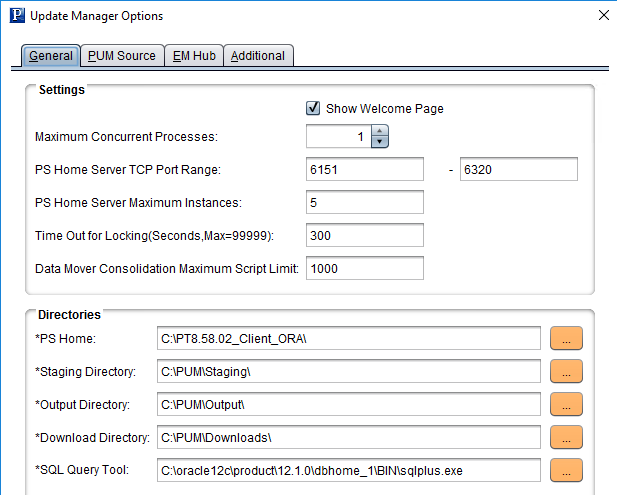
Field or Control |
Description |
|---|---|
Maximum Concurrent Processes |
Specifies the maximum number of processes that can be executed concurrently on the local machine. The default is 1. |
PS Home Server Starting Port |
Specify the port number for the first PS Home server. Change Assistant uses this port number to communicate with Change Assistant PS Home servers. The default starting port number is 6151. If you enter a port number that is already in use, you see an error message. You must change to a port number that is not in use, and then restart Change Assistant for the change to take effect. |
PS Home Server Maximum Instances |
Enter a number between 1 and 10 for the maximum number of PS Home servers. Use this value for environments with more than one PS_HOME. For each server instance, Change Assistant increments the PS Home Server Starting Port number by 1 up to the maximum number of instances. For example, with a PS Home Server Starting Port value of 6151 and a PS Home Server Maximum Instances value of five, the port numbers would be 6151, 6152, 6153, 6154, and 6155. The default is 5. If you change this value, you must restart Change Assistant for the change to take effect. |
PS Home |
Enter the full path to the new PeopleTools release PS_HOME. Note: This is the same PS_HOME used to install Change Assistant. |
Staging Directory |
Enter the directory in which you would like to stage all the Change Assistant upgrade files. This is the location that Change Assistant will store files to be used during the upgrade to new PeopleTools process. |
Output Directory |
Enter the directory in which you want the log files generated by the upgrade process to reside. |
Download Directory |
Enter the full path of the location to which you want to download your change packages. |
SQL Query Tool |
Select the correct executable for the database platform that matches the PS_HOME defined for CA. This value is used as the default when creating environments. Each environment contains separate settings and therefore, you can change this executable for a specific database. Valid SQL query executables for each platform are:
Note: Change Assistant uses the command line version of the .exe, not the GUI version. For example, sqlplus.exe is used for an Oracle database, rather than sqlplusw.exe. Important! Oracle Database Customers: For systems running on the Oracle database, by default, Change Assistant copies the generated SQL script files to the location specified as the TEMP User variable on the Environment Variables dialog box. So, on Oracle, the generated SQL script files will actually exist in two locations: the specified Change Assistant output directory, and the TEMP directory. This behavior is in place because some versions of Oracle SQL Plus do not support pathnames longer than 79 characters. It is recommended that you ensure that the value specified for the TEMP User variable is set to a path short enough so that the string comprising the path and generated SQL file will not exceed 79 characters. |
Additional Options
This example illustrates the fields and controls on the Change Assistant - Additional Options page. You can find definitions for the fields and controls later on this page.
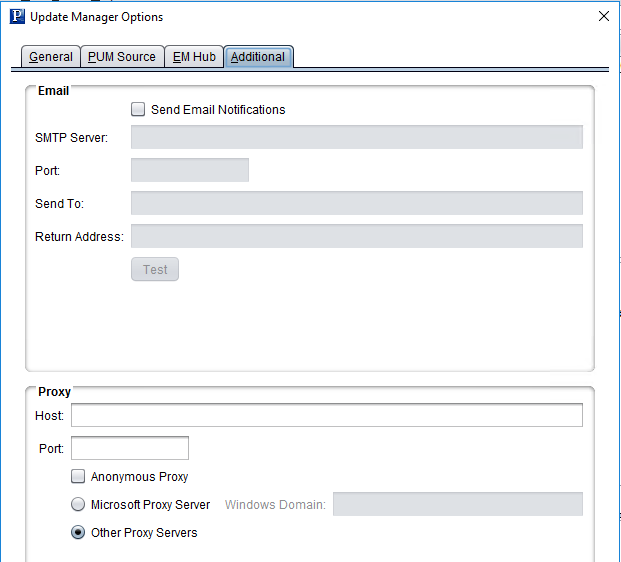
Notification Settings Section
Field or Control |
Description |
|---|---|
Send Email Notifications |
Select this check box to receive email notifications if there are errors in the upgrade process. Change Assistant also sends you a completion message when it encounters a Stop in the update process. |
SMTP Server |
Enter the SMTP mail server from which you receive the error or completion messages. |
Port |
Enter the port from which you want to access the email. |
Send To |
Enter the address to which you want the email sent. |
Return Address |
Enter the email address of the sender. Use this to identify who sent the notification. |
Test |
Validates that email is sent to the designated recipients and is working correctly. Note: Ensure that your SMTP server is installed and configured correctly. |
Proxy Section
Field or Control |
Description |
|---|---|
Host |
(Optional) Enter the name of the proxy server if you want to run Change Assistant behind the firewall using a proxy server. |
Port |
(Optional) Enter the port number for the proxy server. |
Anonymous Proxy |
Indicates that you are using a proxy server that does not require authenticated connections. |
Microsoft Proxy Server |
Indicates that you are using a proxy server with Windows authentication. |
Windows Domain |
The network domain in which the system runs. |
Other Proxy Servers |
Indicates you are using non-Microsoft proxy servers. |
Select Task
Select Upgrade to a New Release of PeopleTools.
This example illustrates the task Upgrade to a New PeopleTools Release selected.
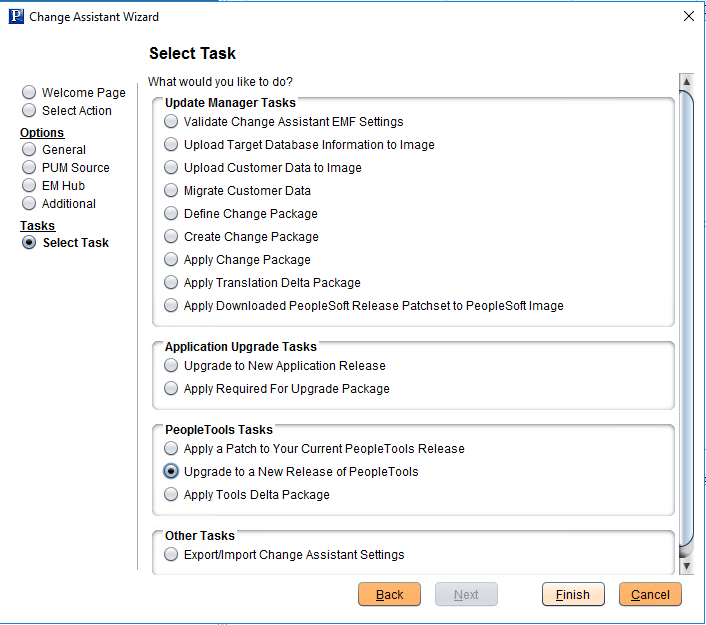
To apply the PeopleTools upgrade, the Wizard will guide you through the environment setup. As you click Next you will complete the following pages:
Change Package Settings
Select Target Database
Select PeopleTools Upgrade
Validation
Apply Summary
Change Package Settings
This example illustrates the fields and controls on the Change Package Settings page for a PeopleTools Upgrade. You can find definitions for the fields and controls later on this page.
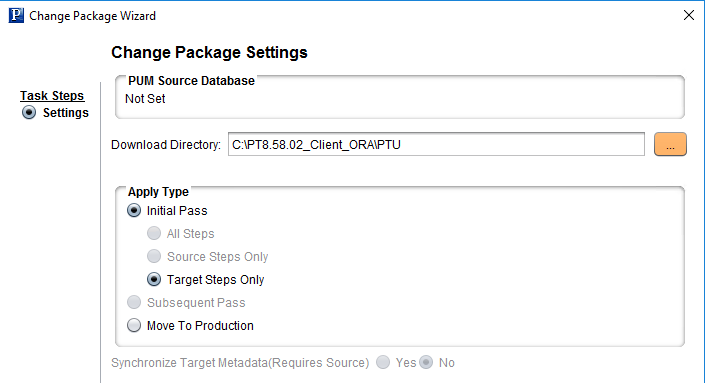
For a PeopleTools upgrade, the apply type is Initial Pass and Target Steps Only.
Select Target Database
On the Select Target Database page, select your target database if the databases were imported to the new instance of Change Assistant.
To create a new database or add the New Homes to an existing database:
Click the Create button, which will launch the Database Wizard.
On the Define Database page, enter the information for the database you are defining.
Note: For PeopleTools Upgrade, you must set the path information for the new PS home locations. You must also ensure that the current PS_APP_HOME and the current PS_CUST_HOME are not set to the current PS_HOME. See Defining Databases
Click Next.
Change Assistant will query the database and gather additional database.
Note: Change Assistant will verify the connection to the database, including User ID/password, Access ID/password, and Connect ID/password. You will need to correct any errors before continuing to define the database.
The information is then displayed on the Additional Database Details page.
Click Next and the Confirm Settings page is displayed.
Click Finish.
Select PeopleTools Upgrade
The select PeopleTools Upgrade page will display the target database information, as well as the change package to install and any PeopleTools patches that Required at Upgrade and downloaded to the download directory.
This example illustrates the fields and controls on the Select PeopleTools Upgrade page.
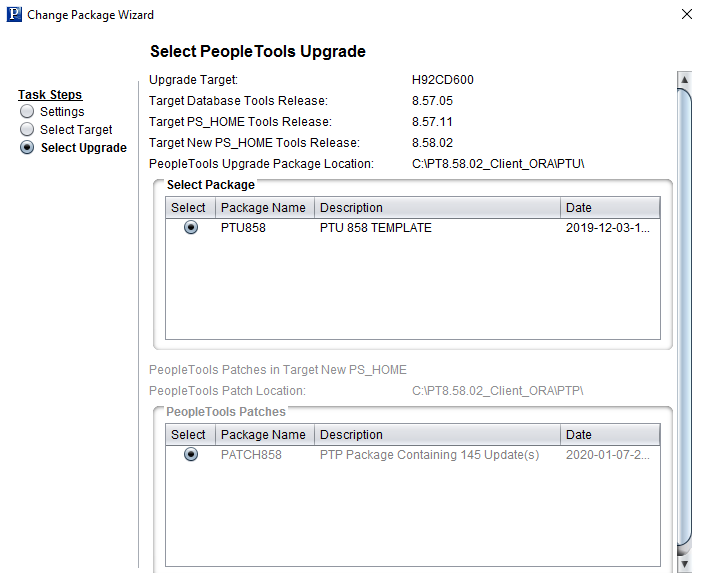
Validation
Change Assistant will check the connectivity to the target database, validate the PTU, and validate the target environment.
This example illustrates the fields and controls on the Validation page.
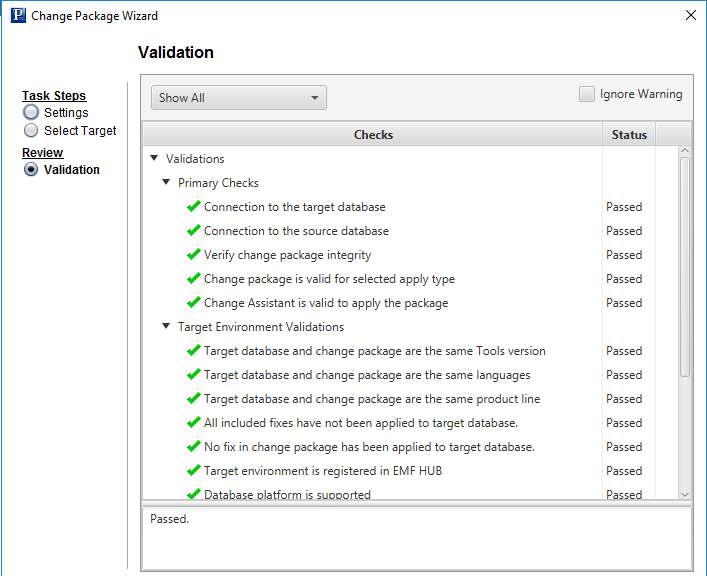
PeopleTools Upgrade Job
When you click Finish on the Summary page, the PeopleTools upgrade job is created and opens. The first step is usually a manual stop.
For more information on running Change Assistant Jobs, see Running the Upgrade Job